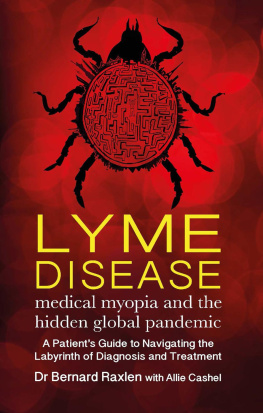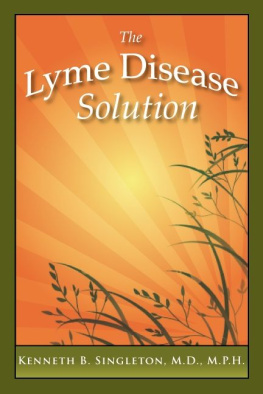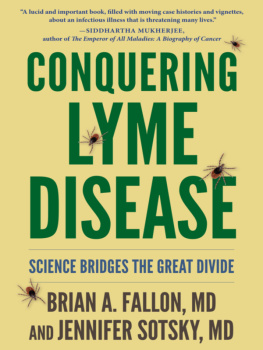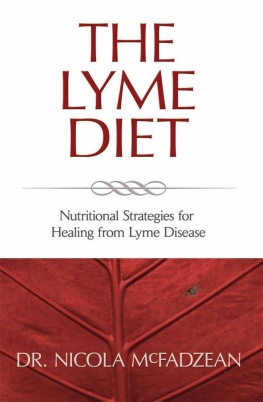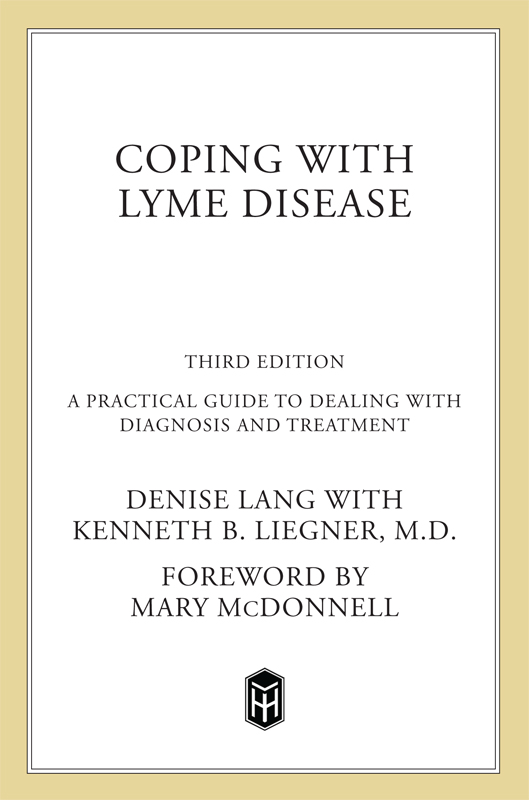
The author and publisher have provided this e-book to you for your personal use only. You may not make this e-book publicly available in any way. Copyright infringement is against the law. If you believe the copy of this e-book you are reading infringes on the authors copyright, please notify the publisher at: us.macmillanusa.com/piracy.
Contents
I.
II.
III.
Appendix A:
Appendix B:
Appendix C:
Appendix D:
For Christopher
Who fought with strength and persistence and won!
Foreword
Several years ago, I started hearing from relatives that my cousin Pat Loughran was losing her husband Jim to the ravages of Lyme disease. The notion that Jim might die from this thing called Lyme disease was simultaneously deeply disturbing and vaguely unreal to me.
I had been through the excruciating experience of watching friends and family members struggle with, and in some cases lose the battle to disease (cancer, AIDS, Alzheimers, heart disease, etc.). My response to these situations was always distinct and vivid. My response to Jims situation had a numbness to it, a kind of distance that I did not understand.
When Jim did eventually die from Lyme, I felt alarmed and very, very angry. Why and how was it possible that this beautiful man could be gone and his family robbed of his life from something so innocuous as a tick bite?
I now recognize my response as common to the early stages of understanding Lyme. My reaction was rooted in ignorance. We as a society are deeply afraid of confronting a disease that can come upon us quietly and without warning, in our most natural and peaceful environments.
Every man, woman, and child who has fallen victim to Lyme, and every member of their devoted families has had to confront this dark and mysterious illness with herculean amounts of tenacity and courage. And so it was, and still is, with my cousin Pat, a remarkable woman possessing the faith and energy of ten women.
Pat invited me to help her and hundreds of others in their noble endeavor to create Lyme disease awareness. And so began the last few years of my being privileged to meet and witness the extraordinary people who are using every spare moment of their lives in the effort to identify, treat, and someday, against all odds, discover the cure for this confounding disease. What I have found in the people who are fighting Lyme is a deep conviction in the preservation of life, a passionate commitment to saving the lives of thousands of children, and a relentless willingness to chip away at the layers of bureaucracy and politics that impede the possibility of cure.
In the following pages, Denise Lang compassionately and practically offers invaluable insight into the world of Lyme. She invites us, with a certainty that comes only through the personal journey of a loving parent, into a world that in her deft hands feels not so vague, not so threatening, and ultimately full of hope.
I am deeply honored to be a part of this truly significant book. I invite you to read it cover to cover, and I implore you to give the book to others. Eventually, if not already, you will know someone afflicted with Lyme. Give that person this book. It is possible that you will help save his or her life.
In Coping with Lyme Disease, Denise Lang bridges the world of torment that confuses and exhausts the Lyme sufferer, to a world of information, understanding, and, at long last, relief. What a treasure this book is. Bravo, and thank you, Denise.
MARY MCDONNELL, ACTRESS
NATIONAL SPOKESPERSON ,
LYME DISEASE ASSOCIATION, INC. (LDA)
Introduction
Soft ocean breezes wafted inland as I sat in the standing-room-only auditorium of Westerly Hospital, in Westerly, Rhode Island, in August of 2002, awaiting the start of an unusual informational seminar on Lyme disease.
Some of the most knowledgeable physicians and activists were scheduled to speak, but we were also to hear from members of the Governors Commission on Lyme Diseasea committee deemed necessary when Rhode Island moved ahead of New Jersey to win the dubious distinction of having the second-highest infection rate in the country. An underlying current of tension permeated what would otherwise have been a lighthearted summer day.
A lovely but worried-looking brunette sat down next to me and extended her hand.
Youre Denise Lang. You wrote the book Coping with Lyme Disease, didnt you? Well, you should talk to me. I just had to sell all my living room and dining room furniture to pay for antibiotics for my two kids.
Tears welled in her eyes.
My husband and I have worked hard all our lives, paid our insurance premiums, tried to be good citizens. But now, when we need help well, Im not sure how much more furniture I can sell. And without the antibiotics, my kids will get really sick. My husband has it, too, but we cant afford to treat him. Some days, I just get really scared.
In those few short moments, a dozen years flashed before my eyes.
When I wrote the first edition of Coping with Lyme Disease, it was in the wake of my then-teenage sons descent into the hell that Lyme can bring upon a family. Ten months of misdiagnosis and being shuffled from specialist to specialist. Ten months of watching a bright, optimistic, and able honors student deteriorate into a shaking, pain-wracked, and depressed boy who whispered as we sat at a traffic light following another unfruitful doctors visit, If I have to spend the rest of my life like this, I dont know that its worth living.
Ten months of financial drain, family tension, sleepless nights, and desperation that eventually contributed to the erosion of my marriage. Ten months of fighting for credibility with doctors, fighting for calm in the face of helplessness, and fighting for the sanity to go on.
And thenfinallya diagnosis and treatment. Successful, long-term treatment, I should add.
All of that flashed through my head in a nanosecond in the face of this upset woman, yet the first conscious thought that popped to mind was, I thought by now, things would be different.
The fact of the matter is things are different from the time of publication of the first edition of this book in 1993 and even the 1997 update. Some of those differences are good, and some are not so good.
The good news is that many more doctors, nurses, scientists, and legislators are aware of Lyme disease and how it can infect the lives of more than just the patient. The Centers for Disease Control (CDC) finally acknowledges the existence of chronic Lyme disease and cautions, in writing, that generally only one out of ten cases is reportedparticularly startling when you consider that cases of reported Lyme hit 23,764 in 2002. And the Surgeon General stated as a goal in Healthy People 2010 to reduce Lyme disease cases by 44 percent in endemic areas.
The bad news is that people in many parts of the country still have to fight for a diagnosis, and too many doctors who are successfully treating Lyme disease have been harassed by ignorant medical boards acting under pressure from insurance companies that dont want to pay for costly medication.
The good news is that the studies, peer-reviewed articles, and research that will enable doctors and scientists to understand, diagnose, and treat Lyme have been, and continue to be, produced. The bad news is that Lyme has now been confounded by a whole host of other tick-borne infections, further complicating an already difficult diagnosis.


